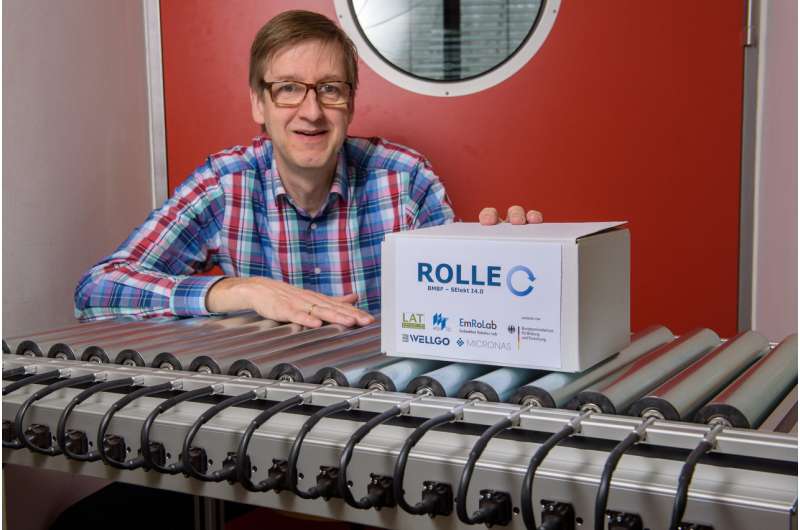Smart conveyor rollers to optimize parcel logistics operations

Engineers from Saarbrücken have developed a system of self-monitoring conveyor rollers to solve crucial logistics problems for sorting offices and parcel services. Drive systems specialist Professor Matthias Nienhaus from Saarland University and his team of engineers have found a way of turning the motor inside every drive roller into a sensor. When the conveyor is running, the drive motors continuously generate data. Using only this data, Nienhaus' technology is able to control each of the conveyor rollers precisely so that it can respond to changing operating conditions. The new technology can be used to provide a cost-effective means of speeding up parcel sorting operations and can deliver greater flexibility wherever conveyor systems are in use. The research engineers from Saarland University are in Hannover to look for industrial partners interested in developing the new technology into marketable products.
The team will be exhibiting a conveyor demonstrator made from these smart rollers at Hannover Messe from the 23rd to the 27th of April at the Saarland Research and Innovation Stand (Hall 2, Stand B46).
Online commerce is booming. Ever greater numbers of packages and parcels need to be shipped quickly to their destinations. This poses huge challenges for parcel services. But speed is not the only thing that has to be optimized—the mountains of packages coming into a parcel sorting hub have to be transported, sorted and distributed in the smallest possible space without interruption and without error. In a parcel sorting centre, there is neither time nor room for parcel pile-ups. And today's parcel sorting hubs have to deal with items whose sizes and weights can differ enormously, from an exercise bike to a book. Conventional flat-bed conveyor belt lines contain huge numbers of tightly packed rollers that are powered by a central drive system. The rollers all rotate in the same direction and at the same speed. "If there's a large gap between two parcels, the gap stays constant as the parcels move down the line. There's no way to change or to define the distance between the parcels," says Professor Matthias Nienhaus of Saarland University. Closing these gaps has not been possible up until now. As a result, the time and space for conveying the parcels is not being used in an optimal way. And if one of the rollers fails, the whole belt can come to a standstill.
Nienhaus and his team of engineers have found a means of making roller conveyors much more flexible and responsive. In their roller conveyor system, each roller runs independently, sometimes running forward, sometimes backward, sometimes rotating a little faster, sometimes a little slower—adjusting its operational state as needed at that specific moment. Unlike the conventional conveyor belts in use at present, each of the rollers in the Saarbrücken system knows just what it is supposed to be doing. "The rollers in our system can detect gaps between the parcels being conveyed and, if they sense a gap, they can rotate faster to close the gap. Or, if parcels are beginning to pile up, the rollers will start to rotate more slowly. If a roller fails, the other rollers will register this fact and can compensate accordingly—so we have a system in which the rollers are effectively communicating with one another," explains Nienhaus.
As the technology does not need any additional sensors, the cost of the new system is extremely attractive. The trick is to focus on the small electric motors inside the rollers. "We record operational data at certain points within the drives. We then use this data to calculate the status of the rotor and to draw conclusions about how it might need to respond. One of the measurements involves determining how the strength of the motor's electromagnetic field is distributed. Inside the electric motor, permanent magnets rotate around coils. Allowing electric current to flow through these coils generates an electromagnetic field. By studying the measurement data, the researchers can see how this field changes as the motor rotates, giving them very precise information about the state of the drive.
"By evaluating this kind of data, we are in a position to control the motors in the rollers very efficiently," says Nienhaus. The drive systems specialists have developed novel procedures that make it easier to analyse the data and to computationally filter out unwanted artefacts. A patent application has been filed. "In future, we'll be using the data for an even more advanced analysis of the drive's operational status," explains Professor Nienhaus. By evaluating angular momentum data, it is possible to determine how heavy a parcel is or whether or not a parcel is actually above a particular roller. "Our methods allow us to observe even the smallest changes in the motors," says Nienhaus. If one of the rollers is no longer rotating because the bearing has worn or because of a short circuit, the magnetic field generated by the motor will change and this will be immediately registered by the system. The system knows which roller is affected and why. "Because each roller has access to a network operating system, thousands of individual rollers can be linked together to form an integrated smart roller system. These rollers are essentially able to communicate with each other and can therefore respond flexibly whenever an unexpected condition arises," explains drive specialist Nienhaus.
The Saarbrücken engineers will be bringing a small conveyor system to Hannover Messe in order to showcase their smart roller technology. The research team is looking for commercial and industrial partners with whom they can develop their system for concrete practical applications.
Provided by Saarland University





















